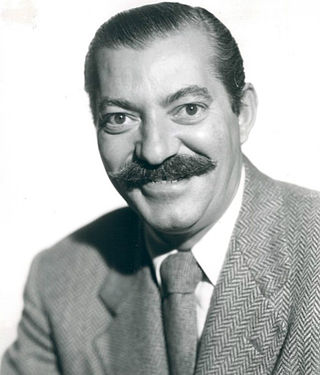
Sylvester J. Pussycat Sr. is a fictional character, an anthropomorphic cat in the Looney Tunes and Merrie Melodies series of cartoons. Most of his appearances have him often chasing Tweety Bird, Speedy Gonzales, or Hippety Hopper. He appeared in 103 cartoons in the golden age of American animation, lagging only behind superstars Bugs Bunny, Porky Pig, and Daffy Duck. Three of his cartoons won Academy Awards, the most for any starring a Looney Tunes character: they are Tweetie Pie, Speedy Gonzales, and Birds Anonymous.

The CooCoo Nut Grove is a 1936 Warner Bros. Merrie Melodies short animated film, set in the famed Cocoanut Grove of the Ambassador Hotel in Los Angeles. The cartoon was directed by Friz Freleng, with animation by Robert McKimson and Sandy Walker, caricature design by T. Hee, and musical score by Carl Stalling. The short was released on November 28, 1936.
The Mouse-Merized Cat is a 1946 Warner Bros. cartoon in the Merrie Melodies series, directed by Robert McKimson. It is a sequel to 1945's Tale of Two Mice, with the Abbott and Costello characterizations cast as mice. A 1942 cartoon, A Tale of Two Kitties, cast Abbott and Costello as cats and introduced Tweety Bird. They are voiced by Tedd Pierce and Mel Blanc respectively. This cartoon marks the final appearances for Babbit and Catstello during the Golden age of American animation.

Book Revue is a 1946 Warner Bros. Looney Tunes cartoon directed by Bob Clampett. The cartoon was released on January 5, 1946, and features Daffy Duck.

Babbit and Catstello are fictional characters, based on the comedic duo Abbott and Costello, that appeared in Warner Bros. animated cartoons. The characters appeared in four cartoons between 1942 and 1946: once as cats, once as dogs, and twice as mice.

Gerardo Luigi Colonna, better known as Jerry Colonna, was an American musician, actor, comedian, singer, songwriter and trombonist who played the zaniest of Bob Hope's sidekicks in Hope's popular radio shows and films of the 1940s and 1950s. He also voiced the March Hare in Walt Disney's 1951 animated feature film Alice in Wonderland.

Slick Hare is a 1947 Merrie Melodies cartoon, directed by Friz Freleng. The film was released on November 1, 1947, and features Bugs Bunny and Elmer Fudd. It parodies the Mocambo nightclub in Los Angeles—in the cartoon referred to as "The Mocrumbo". Mel Blanc voices Bugs, Arthur Q. Bryan voices Elmer Fudd and impressionist Dave Barry portrays Humphrey Bogart. The title is a pun on "hair", from an era when hair slicked down by oil was a popular fashion style for men.

Hollywood Steps Out is a 1941 short Merrie Melodies cartoon by Warner Bros., directed by Tex Avery. The short was released on May 24, 1941.

What's Cookin' Doc? is a 1943-produced, 1944 Warner Bros. cartoon in the Merrie Melodies series, directed by Bob Clampett, and stars Bugs Bunny. The short was also written by Michael Sasanoff, and was animated by Robert McKimson, along with uncredited work by Rod Scribner, Phil Monroe and Virgil Ross. The film was released on January 8, 1944.

Stage Door Cartoon is a 1944 Merrie Melodies cartoon directed by Friz Freleng. The short was released on December 30, 1944, and features Bugs Bunny and Elmer Fudd.

Tale of Two Mice is a 1945 Warner Bros. cartoon in the Looney Tunes series, directed by a uncredited Frank Tashlin. It is a sequel to 1942's A Tale of Two Kitties, with the Abbott and Costello characterizations now cast as mice. They are voiced by Tedd Pierce and Mel Blanc respectively.

Bingo Crosbyana is a 1936 Warner Bros. Merrie Melodies cartoon short directed by Friz Freleng, and notable for its title song, composed by Sanford Green and with lyrics by Irving Kahal. The short was released on May 30, 1936.
Let It Be Me is a 1936 Warner Bros. Merrie Melodies cartoon directed by Friz Freleng. The short was released on May 2, 1936.

Swooner Crooner is a 1944 Warner Bros. Looney Tunes cartoon directed by Frank Tashlin. The short was released on May 6, 1944, and stars Porky Pig.
Hollywood Daffy is a 1946 Warner Bros. Merrie Melodies cartoon, starring Daffy Duck. The cartoon was written by Michael Maltese and was released on June 22, 1946.
The Woods Are Full of Cuckoos is a 1937 Merrie Melodies cartoon directed by Frank Tashlin. The short was released on December 4, 1937.

The Penguin Parade is a 1938 Warner Bros. Merrie Melodies directed by Tex Avery. The short was released on April 23, 1938.

I've Got to Sing a Torch Song is a 1933 Warner Bros. Merrie Melodies animated short film, directed by Tom Palmer. The short was released on September 23, 1933. It premiered with I Loved a Woman in theaters.
The Hardship of Miles Standish is a 1940 Merrie Melodies cartoon directed by Friz Freleng. The short was released on April 27, 1940, and features Elmer Fudd.
Malibu Beach Party is a 1940 Warner Bros. Merrie Melodies cartoon directed by Friz Freleng. The short was released on September 14, 1940.














